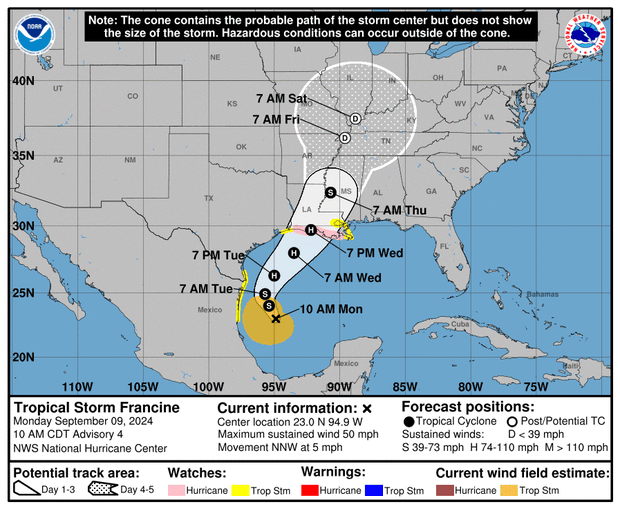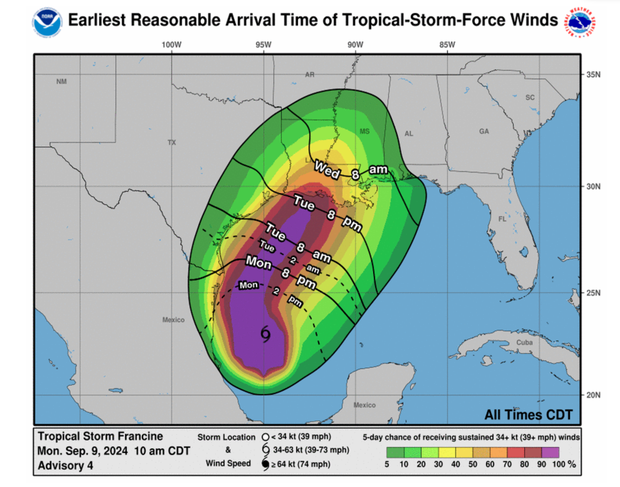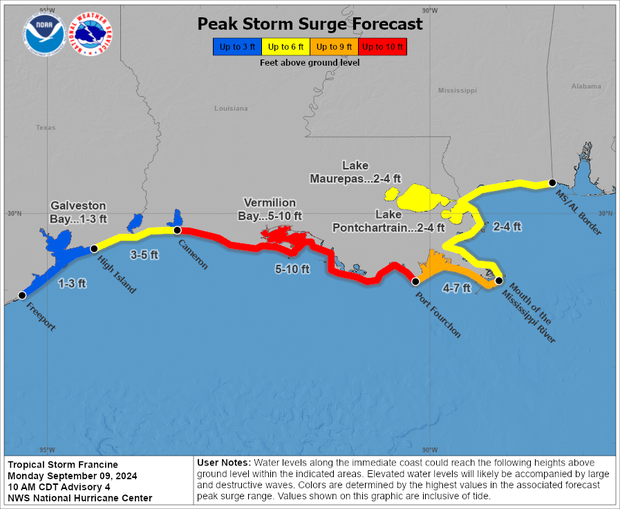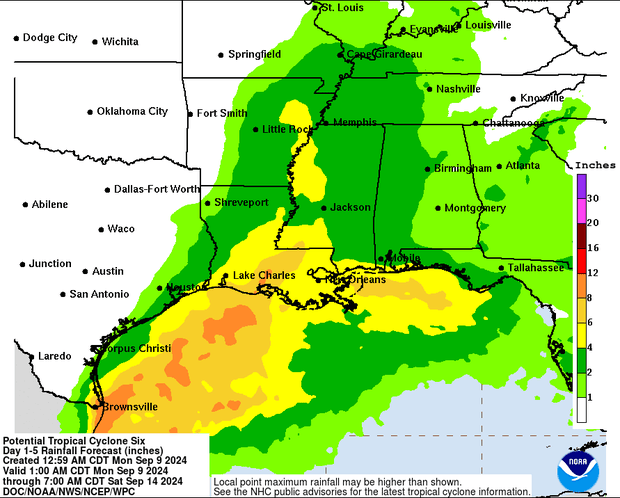Maps show Tropical Storm Francine's path as forecasters predict it will strengthen into a hurricane
Tropical Storm Francine crawled northwestward Monday over the Gulf of Mexico, on a path meteorologists expected to cross onto land somewhere along the coast of Louisiana later in the week. Francine was forecast to continue moving at a sluggish pace before picking up speed Tuesday, while intensifying and, potentially, becoming a hurricane ahead of its predicted Wednesday landfall.
Maps released by the National Hurricane Center illustrated Francine's forecast as the storm gained strength and became more organized Monday afternoon.
"Francine is forecast to be a hurricane when it reaches the northwestern Gulf Coast on Wednesday or Wednesday night and there is an increasing likelihood of life-threatening storm surge inundation for portions of the Upper Texas and Louisiana coastlines where a storm surge watch is in effect," forecasters said in an advisory Monday from the National Hurricane Center, which also pointed to "an increasing risk of damaging hurricane-force winds in portions of southern Louisiana" starting Wednesday.
At 2 p.m. EDT, the center was about 180 miles south-southeast of the mouth of the Rio Grande and about 450 miles south-southwest of Cameron, Louisiana, not far from the eastern Texas border. Francine at the time was traveling north-northwest at 5 miles per hour, which was unchanged from a previous reading earlier in the morning.
Maximum sustained winds clocked in at 60 mph — a solid jump from the 50 mph winds reported three hours earlier by the hurricane center, although still well below the threshold to be considered a hurricane. A tropical storm's maximum wind speeds need to reach 74 mph in order to meet criteria for Category 1 on the Saffir-Simpson Hurricane Wind Scale.
Storm surge, hurricane and tropical storm watches were issued for various parts of coastal Louisiana and Texas when forecasters upgraded Francine at 11 a.m. from its original class as a tropical depression to a full-on storm, and they remained effective into the afternoon. Areas from High Island, Texas, eastward to the border of Mississippi and Alabama were under storm surge watches, including Vermilion Bay, Lake Maurepas and Lake Pontchartrain. A tropical storm watch was active for places east of High Island to Cameron and east of Grand Isle, Louisiana, to the mouth of the Pearl River, also including Lake Pontchartrain and Lake Maurepas, and a hurricane watch was in place from Cameron eastward to Grand Isle.
A storm surge watch means there is a possibility of life-threatening inundation in the watch area within 48 hours. Hurricane and tropical storm watches mean conditions typically associated with those weather events are possible within the same timeframe. Watches are different from warnings, which the hurricane center will issue for areas where the arrival of surges, hurricanes or tropical storms are imminent.
Tropical-storm-force winds extended outward up to 160 miles from the center of Francine Monday afternoon, according to the hurricane center. After slow movement through the remainder of the day, forecasters said the storm would begin to travel faster toward the northeast Tuesday while churning just offshore of the northern Gulf of Mexico. By Wednesday, they anticipated France would approach the Louisiana and upper Texas coastlines following a significant period of intensification overnight and into the morning.
Francine was expected to dump 4 to 8 inches of rain on coastal regions from northeastern Mexico to the southern and upper Texas coasts, and across southern Louisiana and southern Mississippi through Thursday morning, but up to a foot of rainfall could accumulate in certain parts. There was a risk of "considerable" flash flooding and urban flooding because of that, forecasters warned, noting that dangerous storm surge linked to Francine could compound the tide and flood coastal places that way, too.
If peak surge and high tide do happen together, water levels from Cameron to Port Fourchon, Louisiana, an around Vermilion Bay, could rise between 5 and 10 feet above ground levels, the hurricane center said. Levels could reach 4 to 7 feet from Port Fourchon to the mouth of the Mississippi River, and 3 to 5 feet from Cameron to High Island.
Forecasters said Francine appeared to shift slightly eastward between Monday morning and the early afternoon, suggesting the storm would move ashore in Louisiana at some point on Wednesday evening. That was a small shift from earlier trajectories that indicated Francine would make landfall in either Louisiana or eastern Texas.
"The estimated motion is still tricky given the center only recently formed," they said in an advisory at 11 a.m., which acknowledged that some elements of Francine's track remained uncertain.







